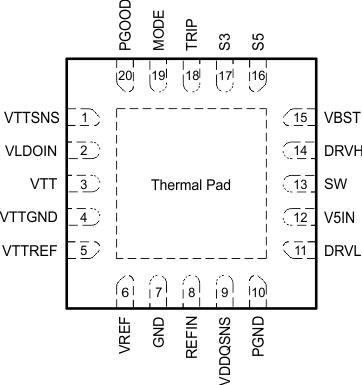JAJSOE8A November 2015 – July 2022 TPS51216-EP
PRODUCTION DATA
- 1 特長
- 2 アプリケーション
- 3 概要
- 4 Revision History
- 5 概要 (続き)
- 6 Pin Configuration and Functions
- 7 Specifications
- 8 Detailed Description
- 9 Application and Implementation
- 10Power Supply Recommendations
- 11Layout
- 12Device and Documentation Support
- 13Mechanical, Packaging, and Orderable Information
パッケージ・オプション
メカニカル・データ(パッケージ|ピン)
- RUK|20
サーマルパッド・メカニカル・データ
- RUK|20
発注情報
6 Pin Configuration and Functions
 Figure 6-1 RUK Package
20-Pin WQFNTop
View
Figure 6-1 RUK Package
20-Pin WQFNTop
ViewTable 6-1 Pin Functions
| PIN | I/O | DESCRIPTION | |
|---|---|---|---|
| NAME | NO. | ||
| DRVH | 14 | O | High-side MOSFET gate driver output. |
| DRVL | 11 | O | Low-side MOSFET gate driver output. |
| GND | 7 | — | Signal ground. |
| MODE | 19 | I | Connect resistor to GND to configure switching frequency and discharge mode. (See Table 8-2.) |
| PGND | 10 | — | Gate driver power ground. RDS(on) current sensing input (+). |
| PGOOD | 20 | O | Powergood signal open drain output. PGOOD goes high when VDDQ output voltage is within the target range. |
| REFIN | 8 | I | Reference input for VDDQ. Connect to the midpoint of a resistor divider from VREF to GND. Add a capacitor for stable operation. |
| SW | 13 | I/O | High-side MOSFET gate driver return. RDS(on) current sensing input (–). |
| S3 | 17 | I | S3 signal input. (See Table 8-1.) |
| S5 | 16 | I | S5 signal input. (See Table 8-1.) |
| TRIP | 18 | I | Connect resistor to GND to set OCL at VTRIP / 8. Output 10-μA current at room temperature, TC = 4700 ppm/°C. |
| VBST | 15 | I | High-side MOSFET gate driver bootstrap voltage input. Connect a capacitor from the VBST pin to the SW pin. |
| VDDQSNS | 9 | I | VDDQ output voltage feedback. Reference input for VTTREF. Also serves as power supply for VTTREF. |
| VLDOIN | 2 | I | Power supply input for VTT LDO. Connect VDDQ in typical application. |
| VREF | 6 | O | 1.8-V reference output. |
| VTT | 3 | O | VTT 2-A LDO output. Need to connect 10 μF or larger capacitance for stability. |
| VTTGND | 4 | — | Power ground for VTT LDO. |
| VTTREF | 5 | O | Buffered VTT reference output. Need to connect 0.22 μF or larger capacitance for stability. |
| VTTSNS | 1 | I | VTT output voltage feedback. |
| V5IN | 12 | I | 5-V power supply input for internal circuits and MOSFET gate drivers. |
| Thermal pad | — | — | Connect to GND |